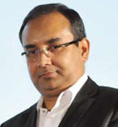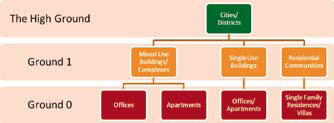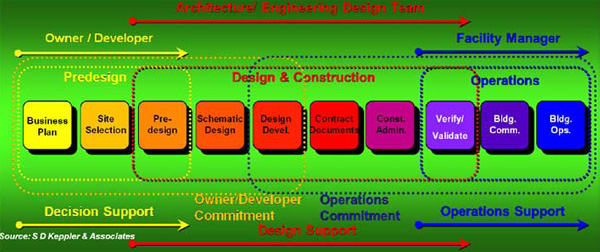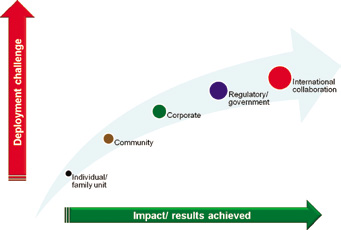Sustainable development is in danger of becoming a passing fad, with everyone in the industry wanting to pay lip service to it. Sougata Nandi argues that it needs to be financially profitable, environmentally responsible and socially sensitive, and demonstrates ways of integrating it in development projects.
Sustainable development is in danger of becoming a passing fad, with everyone in the industry wanting to pay lip service to it. Sougata Nandi argues that it needs to be financially profitable, environmentally responsible and socially sensitive, and demonstrates ways of integrating it in development projects.

Sougata Nandi
“Sustainable development” has become an over-exploited buzzword over the past five years in the Middle East – over-used, misused and abused by people associated with the commercial exploitation of sustainable development. But in the backdrop of the sustainability buzz, there is an undercurrent of serious and concerted efforts by many to adopt some type of best practice or the other. These initiatives have ranged from the much-debated carbon-neutral city development to the halogen-replacement programme and from solar power generation to simple retrofit of restrictors in water fixtures. It has extended to full-fledged energy conservation programmes and lifestyle changes and from LEED-certified complexes to LEED-certified commercial interiors. The GCC region has been witness to all this – that, too, in a short span of less than three years.
The region has had the fastest growing number of LEED- certified projects. A range of well-diversified initiatives have invaded the region from Ras Al Khaimah to Jordan. Projects like Masdar have caught the imagination of the world, while sustainable development initiatives at TECOM Investments have impressed professionals from the US Green Building Council to those in the local industry. Different agencies, government bodies and private initiatives have put in efforts in their own way to push the sustainable development agenda. The question that begs answering is, where does one start and how would the efforts to achieve sustainable habitats, bear fruit?
WHAT IS SUSTAINABLE DEVELOPMENT?
The definition of sustainable development has become a cliché. Having said that, it is my belief that all practitioners of sustainable development, whether they are technically qualified or otherwise, should memorise the following definition of sustainable development, which forms the crux of sustainability: Sustainable development is a process of developing land, cities, business, communities, and so one that “meets the needs of the present without compromising the ability of future generations to meet their own needs”. (Source: Brundtland Report, a 1987 report from the United Nations.
This definition is critically important, because it has an elemental focus on the end-result that sustainable development must achieve. The beauty of this definition is that it does not limit one to specific measures or initiatives, but allows the flexibility to take whatever means necessary, in order to achieve the simple result of ensuring that the present generation does not compromise the ability of the future generations to meet their needs.
This definition has been used very effectively by the Sustainable Energy and Environment Division (SEED) at TECOM Investments. I can safely say that SEED has been able to significantly reduce the footprint of TECOM’s present and future developments. In this context, it is important to understand that for developmental purposes, resources must be utilised, else, development will not take place. However, the key question to address would be, how well this development process can be managed so that minimal resources are being utilised to achieve the desired level of development.
PARADIGMS OF SUSTAINABLE DEVELOPMENT
Sustainable development, in the context of developing land, cities, business and communities, can mean a plethora of initiatives or actions. The impact of these initiatives or actions is largely dependent on three broad paradigms – at what level of hierarchy of a development are these being applied? When during the life cycle of development are these being applied? And, who are deploying these initiatives? Without a clear understanding of these three paradigms, sustainable development initiatives invariably fail, because either they are being deployed at the wrong time in the life cycle of a project or at the incorrect level or by the incorrect people. Therefore, let us first take a quick look at the three paradigms.
Paradigm 1:
Paradigm 1 captures hierarchy of projects. It is a simultaneous bottom-up and top-down paradigm, which is created to essentially demonstrate how sustainable development initiatives can be big and small and, yet, stay relevant within the context of project sizes.

Figure 1: Paradigm 1 – Projects hierarchy
Development projects come in different shapes and sizes. In fact, every action of our existence, has an impact on, and is impacted by, tenets of sustainable development. When we fit-out our new homes and offices, we use resources – furniture, paint, equipment, carpet, cleaning chemicals, lighting, air conditioning and many other materials. This happens at the very fundamental level or Ground 0, as I refer to it. When we start consolidating these small units together, we enter the next level of big buildings – single-use residential or commercial buildings, mixed-use buildings or complexes, residential communities and commercial business districts (CBDs).
Development of these consumes even higher quantities of resources. We are now not limited any more to a few lights or furniture or equipment anymore. We need hundreds of these that are almost largely made of virgin material, putting tremendous stress on the resources of the planet. In the current state of affairs, most of these materials are also environmentally unfriendly – toxic raw materials like mercury in fluorescent lighting – or resource inefficient in their operation, like halogen lamps. The pressures from these substances are not only on virgin raw materials but also due to enormous ecological problems when these need to be disposed of, once their useful life is over.
While in small numbers, such toxic materials can be easily absorbed by the Earth’s eco-system; when these are disposed of in their thousands and millions without a proper mechanism, we are potentially running huge ecological risks. This is Ground 1, several combinations of which lead us to the High Ground or the level of cities/districts.
A large number of modern-day developments are in the form of new cities – Dubai Marina City, or Dubai Silicon Oasis. This is a trend seen not only in our vicinity but also in many other parts of the world. The materials required to build such cities, their ongoing energy and water requirements are now in the order of millions – millions of square feet of glass and carpets, millions of litres of paints, millions of kWh of energy and millions of gallons of potable water…. Thus, if the impact of one high-rise tower is significantly negative on the ecology of the planet, the impact of development of cities/districts are truly gigantic in proportion.
Why is this called High Ground? The city/district level of development is referred to as the High Ground, because in the hierarchy of projects, they have the maximum impact on sustainable development, whereby any action taken at this level will help us achieve the High Ground in the battle for sustainable development. However, it is important not to ignore actions at the Ground 0 level, because an accumulation of many small aberrations also leads to major ecological disasters. Thus, action is required at all levels of developmental hierarchy.
An aside: How important is sustainable development activity at Ground 0 level? If everyone on this planet were to live their lives the way people live in the UAE, we would need the resources of 11 Earths! Sustainable development at Ground 0 is all about leading a certain lifestyle and its impact, on a cumulative basis, on our planet.
Paradigm 2:
Paradigm 2 is the paradigm of project life cycle. In order to understand this paradigm, we need to understand the traditional design and construction process and the factors that have maximum influence at the various stages of this process. Figure 2 will describe this better.

Figure 2: Paradigm 2 – Traditional design and construction process
By and large, the process for development projects is fundamentally the same. It starts with a business plan – even the development projects launched by governments. All projects need to be financed (Capex); all projects need to be operated and maintained (Opex); all projects (except perhaps for government-financed specific development projects that are executed for the betterment of certain sections of the population) need to have a return on investment.
Generally, the engineering and architectural design of projects are also largely dictated by financial considerations (yes, the architectural and engineering designs come first, but they are required to remain within the confines of the financial model). While taking decisions based on financial considerations is necessary and commercially a sound idea, the unfortunate aspect of this is that, most decisions are based on first-cost considerations, rather than lifecycle costing. Therefore, as a case-in point, most projects in this part of the world utilise air-cooled energy and inefficient chillers, which are much cheaper to set up (low Capex), although they have higher ongoing O&M costs and, thus, more expensive on the basis of lifecycle costing.
Very rarely have I come across business plans that have sustainable development built into the financial model of the project. How so? How do you actually incorporate elements of sustainable development in the financial model of a development project? Typically, the financial model of development projects are built around several parameters, namely: (a) Capital Expenditure – includes MEP equipment, civil works, furnishing, etc. (b) Total BUA – square feet of areas to be built-up, which includes service areas as well as leasable areas (c) Spread and balance of commercial, residential, retail, public services etc – this spread and balance control the revenues, either via sale or lease and, therefore, the IRR, (d) Operating Expenditure – largely includes operation & maintenance costs of equipment, cleaning costs of the built-up areas, costs for security, etc. (e) Other costs – fees, etc.
At first glance, this strategy of financial modelling may not allow the opportunity to integrate sustainable development, as all numbers are based on financial terms. Particularly for commercial people who build these financial models, and this is where the engineers need to step in. Based on our knowledge of the cost-benefits of building green, energy-efficient equipment (like chillers, lighting and the like), and renewable energy technologies, the Capex and Opex numbers can be massaged to incorporate some of the sustainable development measures.
Integrating these numbers into the financial model, one at a time, also helps take decisions on which measures to adopt in a financially feasible manner. In the instances of sustainable construction material, like environmentally friendly paints or carpets, there may not be direct cost benefits, but one can always include the upfront Capexes required for such measures. The final decision on such matters would have to be supported by the project owner.
Paradigm 2 is critical purely from the financial point of view. If such decisions are not supported at the business plan stage by the project owner, the opportunity for integrating these measures at the latter stage of the lifecycle of the project would be completely lost. The cost-benefit advantage of adopting a solar photo-voltaic garden lighting system is maximum during the design stage. Once the project is designed with conventional garden lights, retrofitting the same with SPV lighting during the building operation stage will rarely make financial sense. The same principle applies to all sustainable development measures that are currently out of the ordinary for the traditional design-development process, especially for those measures that cost more than their conventional counterparts.
Paradigm 3:
Paradigm 3 is the paradigm of deployment versus impact. This is somewhat similar to the 80:20 Pareto principle – 80% of the impact will come from 20% efforts. This was one of the first principles taught to us when we started learning about energy conservation in college, and over the years, the significance of this principle has only grown exponentially in stature.

Figure 3: Paradigm 3 – Levels of deployment – challenges and impact
At a very elemental level, human beings are generally responsible people. Given an opportunity to recycle, people will usually do it, although this might inconvenience them a bit. Therefore, it is quite easy to get people to replace their halogen light bulbs with Compact Fluorescent Lamps (90% reduction in energy consumptions, carbon emissions and utility bills) or to install restrictors on the taps of their washbasins at homes. During the implementation of sustainable development projects at TECOM, we have had colleagues coming over to secure energy efficient lamps and water restrictors for installation at their homes. The deployment was easy. Unfortunately, the impact of these are negligible in the context of the overall development works going on all around us.
When we rolled the Sustainable Development Policy at TECOM Investments in August 2006, the first challenge we faced was that of a lack of availability of sustainability services and products – largely unavailable, because there was no demand for these at the time. Our then project development stakeholders would all actively oppose our desire of building green, clearly stating that this was not possible in Dubai. This was in 2006.
Over the past four years, and after several workshops, we have managed to change this mindset. Today, not only is green building possible in Dubai, but we also have five of them certified as well, achieved by working together with the “doubting Thomases”. The negative stance has turned around to one of positive enthusiasm today, with all stakeholders in the development process falling over themselves to provide sustainability services.
The deployment was, no doubt, challenging, but possible, and the impact tremendous. At the other end of the supply chain, a vendor could well take a similar decision to sell only environmentally friendly paints, which would have a long-lasting impact on the development projects. A small decision, yet a huge impact.
PARADIGM-DRIVEN SUSTAINABLE DEVELOPMENT
The three paradigms are essentially a snapshot of my personal experiences in deploying sustainable development initiatives over the past 15 years. While these initiatives can come in different shapes and sizes, focusing on the initiatives that make business sense have always met with success. This is particularly critical in the context of commercial organisations, whose main objective is to make profit. If sustainable development initiatives do not make business sense, they simply would not be allowed to survive. A case in point is the still struggling Solar Photovoltaic industry that has been around for decades, but yet to make the kind of impact that was originally expected of it. SPV technology simply does not make financial sense, today. It is about financial profitability.
But then, sustainable development is not only about financial profitability but also about social and environmental performance. This is the concept of “triple bottom-line” – deployment of sustainable development initiatives not only achieve fiscal profitability but also reduce the environmental footprint and contribute to social benefits, all at the same time. What better initiative than these for commercial organisations?
Having contextualised the three diverse paradigms of sustainable development, the key question that needs to be asked is, how do we bring all these paradigms together and deploy sustainable development in an effective manner?
Sustainable development cannot be a standalone initiative. We have seen a manifestation of this while developing green buildings. The requirement of a building to be in close proximity of bus stops and railway stations clearly illustrates that a green building is part of a larger whole. Therein lies the role of government in building infrastructure, especially connecting new developments. And there are many more such facets in the run-up to achieving sustainable development. For sustainable development to truly achieve great results, all stakeholders of the development process need to be aligned, even though the key driver would have to be the developer.
While developing the masterplan of a model sustainable community in Dubai recently, we had the opportunity to apply sustainable development at all three paradigms described earlier. First and foremost, sustainable development was being deployed by a master developer (Corporate). Second, this was being deployed at the High Ground level of developing a self-contained multi-purpose free zone. Finally, and most significantly, sustainable development principles were being deployed at the pre-design, schematic design and business plan level. The combination of these three paradigms was designed to deliver the maximum impact in achieving a sustainable development project that would be financially profitable, environmentally responsible and socially sensitive. So, what did we learn from this experience?
1. Deploying sustainability at the community/city development level, especially from the very early stages of design, can have the most significant impact. A master developer is perfectly positioned to develop and administer development control regulations (DCRs) for individual developments within the community. These DCRs must include specific design parameters like allowed electrical load, HVAC, potable water and waste water generation for individual developments. When ceilings like these are set out for all individual developments in the community, the demands on utility requirements can be reduced significantly. This is the first principle of a resource-efficient design (source: USGBC) – reducing demand.
Moving away from the traditional way of designing for real estate projects, if a master developer were to enforce energy and water design based on a green building development guideline, the utility resources can be reduced proportionally to the level of efficiencies set out.
Considering that traditional way of designing would require 100 units of electricity and 100 units of potable water, a cost-sensitive and practical deployment of sustainability principles can easily reduce these requirements by up to 25% and 30% respectively for electricity and water. This can be achieved without incurring any significant additional capital expenditure. Thus, the business model of the project already starts looking better, because throughout the lifecycle of the project, operating expense reduction will accrue, without having to incur additional Capex.
2. The next step would be to satisfy the remaining 75% of electricity and 70% of water via free resources that can be harnessed at site. There are a variety of free resources available at site in this part of the World. Given the variety of financial and technical constraints, this approach needs to encompass several options. Since offices function largely in daytime, a large portion of the lighting energy requirement can be met using daylight.
Condensate from HVAC systems is another free resource, particularly during high humidity months (August, September). In one of our projects, the condensate lines was connected to the irrigation tank, thus minimising requirement of potable water for landscape. Measures such as these need to be implemented at individual development level and may not be feasible at the level of the master developer.
At the city/community level, a solar farm, generating electricity from the energy of the sun, becomes a viable option. This is, of course, subject to appropriate regulation allowing the connection of such power to the grid – therein lies the role of the government.
A measure, such as utilising TSE water for landscape irrigation (sourced from either its own sewage treatment plant or from the municipality’s supply lines), is already common practice in Dubai. Although TSE may not be classified strictly as free site resource in the same way as solar energy, it is, in a manner of speaking, waste that is a resource available at site. One of the most exciting measures that was embedded in our infrastructure design was the use of solar photovoltaic (SPV) street lighting. The measure works wonderfully well at the design stage of a project, because it offsets the requirement of conventional power generation, reduces sub-station capacity requirement, eliminates costly initial feeder stations and cabling and completely avoids ongoing energy requirements. At the design stage, since it offsets several other Capexes, it becomes somewhat financially “acceptable” to integrate SPV outdoor lighting.
With appropriate use of such technologies, the required resources can be further reduced to around 50% to 60% of electricity and 40% to 50% of water for the overall community.
3. The final step in the application of sustainability, is thus, to satisfy the remaining “unavoidable” requirement for electricity and water. And this needs to be done in the most efficient way possible. This step largely applies to energy rather than water. A few simple measures have already achieved some amount of traction in Dubai. They are:
District cooling is an interesting conundrum. It works on the principle of economies of scale and, thus, achieves significant system efficiencies – theoretically. To achieve these efficiencies in practice, the deployment of such systems need to be done in a measured manner. Fundamentally, a district cooling system requires certain minimum amount of cooling requirement in order to function cost effectively (Capex and Opex).
For permanent district cooling plants to be set up, large sections of the development need to come up and be commissioned at the same time. Since chilled water supply systems do not work in a similar manner as high-tension power supply systems, it is a challenge for district cooling networks to grow organically. Thus, the master developer needs to ensure that the overall project is phased out in such a manner that clusters are developed, rather than individual developments all over the project. This leads to the concept of distributed district cooling systems, which we found to be financially and technically more attractive and practical, in order to extract the benefits of district cooling systems. In this concept, instead of setting up one district cooling plant for a development of 10 million square feet built-up area, it would be advisable to have three to five plants, each catering to corresponding cluster development.
KEY RECOMMENDATIONS
Sougata Nandi is Executive Director, Asset Management & Sustainable Development, TECOM Business Parks Operations. He is Emirates Energy Award Winner 2007. He can be contacted at <Sougata.nandi@tecom.ae>.
Copyright © 2006-2025 - CPI Industry. All rights reserved.